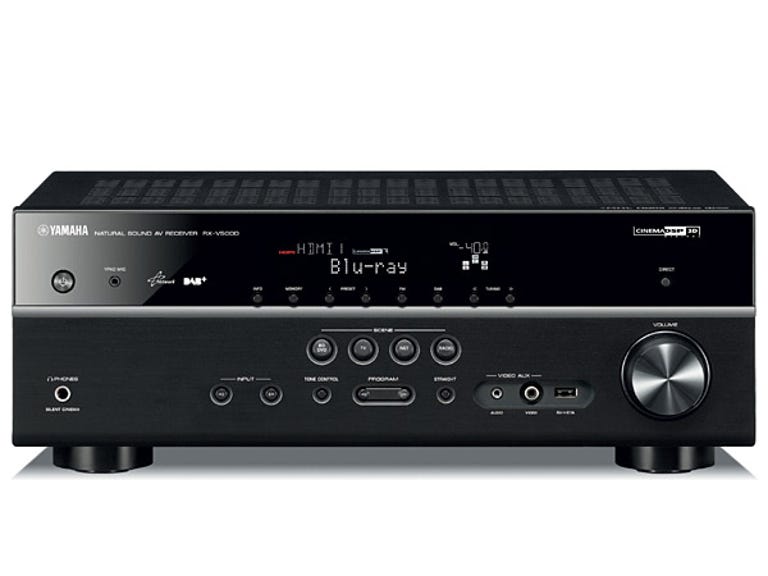 Why You Can Trust CNET
Why You Can Trust CNET Yamaha RX-V500D review: Yamaha RX-V500D
The Yamaha RX-V500D is a competent entry-level home-theatre receiver with network functions, and is the first receiver to include DAB+ digital radio.
Yamaha's RX-V500D home-theatre receiver is unique, which is something that can rarely be said of such products. What makes it unique is the inclusion of a DAB+ radio tuner. It still has FM, but no longer has AM, so it is not suited to most Australians in country and regional areas from which the federal government is still withholding digital radio.
The Good
The Bad
The Bottom Line
Aside from that, there are plenty of modern networking features packed into a unit that offers solid, if basic, home-theatre functionality.
By basic, I mean that it has five amplifier channels rather than seven, which is no great loss for the majority of users who never wire up the extra pair. Each is rated somewhat unusually: 80 watts into 6 ohms. Eight ohms is the normal rated load, and the higher the impedance, the lower the power. A naive conversion would put this receiver at 60 watts per channel into 8 ohms (which further translates to reduction in output of 1.2 decibels compared to an 80-watt unit, so there's not much in it).
There is no support for other zones, and only one HDMI output. But there are five HDMI inputs, one of which supports MHL (mobile high-definition link for video and sound from supporting mobile devices). Both 3D and 4K signals are supported by the HDMI pathway.
There's a USB socket on the front panel and Ethernet on the rear. A useful extra on the front is a 3.5mm input so you can plug any portable audio player in quite conveniently. Also on the back is what looks like a USB socket, but is actually just a 5-volt power supply. This is primarily to power Yamaha's optional Wi-Fi adapter — the YWA-10, $149.
Set-up
As is the norm for home-theatre receivers, it comes with a microphone and an auto-calibration routine. Aside from setting speaker sizes, distances and levels, it includes an equalisation function that can reduce tonal imbalances produced by some loudspeakers.
You can set the FM and DAB+ stations in your area to presets. The one internet-based facility is vTuner-based internet radio. This also works best with a bit of setting up. You can use a computer to log on and set up favourite radio stations and podcasts for easy access by this receiver within excess of 30,000 of these available through the vTuner service.
Sound and video
This was a sweet-sounding receiver. It would not be suitable for exotic, low-impedance, low-sensitivity loudspeakers, but most speakers of commensurate value — say, in the range of AU$1000 to AU$3000 for a 5.1-channel system — ought to work nicely. I used it with some well-behaved floor-standing speakers and two different subwoofer/satellite systems, and all worked well, producing high levels of unstressed sound. All the decoding worked as it should.
The USB input supported the usual MP3 and WMA formats, but adds AAC, including the m4a extension used by iTunes and stereo FLAC, all the way up to 24 bits and 192kHz. Likewise for two-channel WAV. If you have a bunch of high-resolution music files, this unit will be happy to play them.
You can also plug an iPod/iPhone/iPad into the front panel. Then use the HDMI/MHL connection at the back for your other mobile videos and audio. Once plugged in, you can use the receiver's remote control to navigate video and audio content and control playback with both kinds of device.
The receiver does not process video. It won't upscale it. However, it does overlay its menus and indicators (for example, when you change the volume) over all formats I was able to test (everything but 4K), including full HD and 3D. With the latter, it was disconcerting, because the menus and such were visible only to the left eye, which tends to give an uncomfortable sensation. It's best to close your right eye when playing with the menus, in that case.
Usability
Importantly, the receiver was a pleasure to use. It worked first go with all my other devices, and remote-controlled them without fussiness. The iPod and Android control apps worked first go and both provide Airplay-like streaming functionality from within the app. If your Android phone is full of music, you can easily stream it wirelessly to this receiver (assuming you have a wireless network, of course). With iOS, you can also use Apple Airplay itself.
There are also good accelerator functions for scooting through long lists of media, such as those in an iPod or on a USB drive or being served up by DLNA or offered to you by vTuner. Simply navigate to on-screen arrows that will jump through a list, one page or 10 pages at a time.
One disappointment, though, was the failure of the unit to fully integrate the DAB+ tuner into the system. It sounded fine and worked reliably, and you can get information on things like the audio bitrate and such on the receiver's front panel display, but nothing is provided to your TV. DAB+ does include provision for the broadcast of cover art and such, but you won't be able to take advantage of that with this unit.
Conclusion
Perhaps I'm being a bit whiny. This is, after all, the only proper home-theatre receiver so far on the Australian market with a DAB+ tuner built in. With good all-round audio performance and a reasonable price, that makes it all worthwhile.


